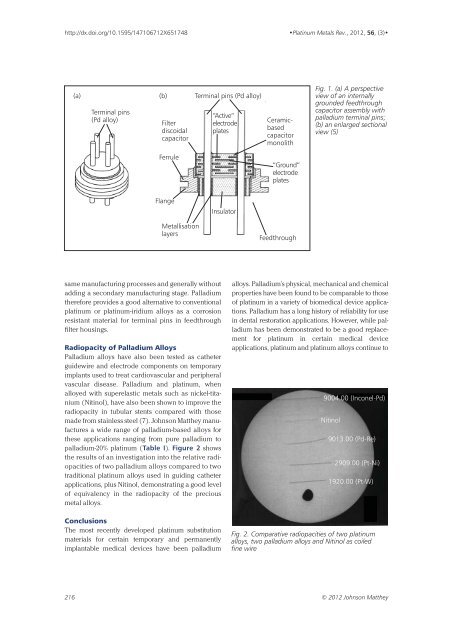Download article PDF - Platinum Metals Review
Download article PDF - Platinum Metals Review
Download article PDF - Platinum Metals Review
You also want an ePaper? Increase the reach of your titles
YUMPU automatically turns print PDFs into web optimized ePapers that Google loves.
http://dx.doi.org/10.1595/147106712X651748<br />
•<strong>Platinum</strong> <strong>Metals</strong> Rev., 2012, 56, (3)•<br />
(a)<br />
Terminal pins<br />
(Pd alloy)<br />
(b)<br />
Filter<br />
discoidal<br />
capacitor<br />
Terminal pins (Pd alloy)<br />
“Active”<br />
electrode<br />
plates<br />
Ceramicbased<br />
capacitor<br />
monolith<br />
Fig. 1. (a) A perspective<br />
view of an internally<br />
grounded feedthrough<br />
capacitor assembly with<br />
palladium terminal pins;<br />
(b) an enlarged sectional<br />
view (5)<br />
Ferrule<br />
“Ground”<br />
electrode<br />
plates<br />
Flange<br />
Insulator<br />
Metallisation<br />
layers<br />
Feedthrough<br />
same manufacturing processes and generally without<br />
adding a secondary manufacturing stage. Palladium<br />
therefore provides a good alternative to conventional<br />
platinum or platinum-iridium alloys as a corrosion<br />
resistant material for terminal pins in feedthrough<br />
filter housings.<br />
Radiopacity of Palladium Alloys<br />
Palladium alloys have also been tested as catheter<br />
guidewire and electrode components on temporary<br />
implants used to treat cardiovascular and peripheral<br />
vascular disease. Palladium and platinum, when<br />
alloyed with superelastic metals such as nickel-titanium<br />
(Nitinol), have also been shown to improve the<br />
radiopacity in tubular stents compared with those<br />
made from stainless steel (7). Johnson Matthey manufactures<br />
a wide range of palladium-based alloys for<br />
these applications ranging from pure palladium to<br />
palladium-20% platinum (Table I). Figure 2 shows<br />
the results of an investigation into the relative radiopacities<br />
of two palladium alloys compared to two<br />
traditional platinum alloys used in guiding catheter<br />
applications, plus Nitinol, demonstrating a good level<br />
of equivalency in the radiopacity of the precious<br />
metal alloys.<br />
Conclusions<br />
The most recently developed platinum substitution<br />
materials for certain temporary and permanently<br />
implantable medical devices have been palladium<br />
alloys. Palladium’s physical, mechanical and chemical<br />
properties have been found to be comparable to those<br />
of platinum in a variety of biomedical device applications.<br />
Palladium has a long history of reliability for use<br />
in dental restoration applications. However, while palladium<br />
has been demonstrated to be a good replacement<br />
for platinum in certain medical device<br />
applications, platinum and platinum alloys continue to<br />
9004.00 (Inconel-Pd)<br />
Nitinol<br />
9013.00 (Pd-Re)<br />
2909.00 (Pt-Ni)<br />
1920.00 (Pt-W)<br />
Fig. 2. Comparative radiopacities of two platinum<br />
alloys, two palladium alloys and Nitinol as coiled<br />
fine wire<br />
216 © 2012 Johnson Matthey
















